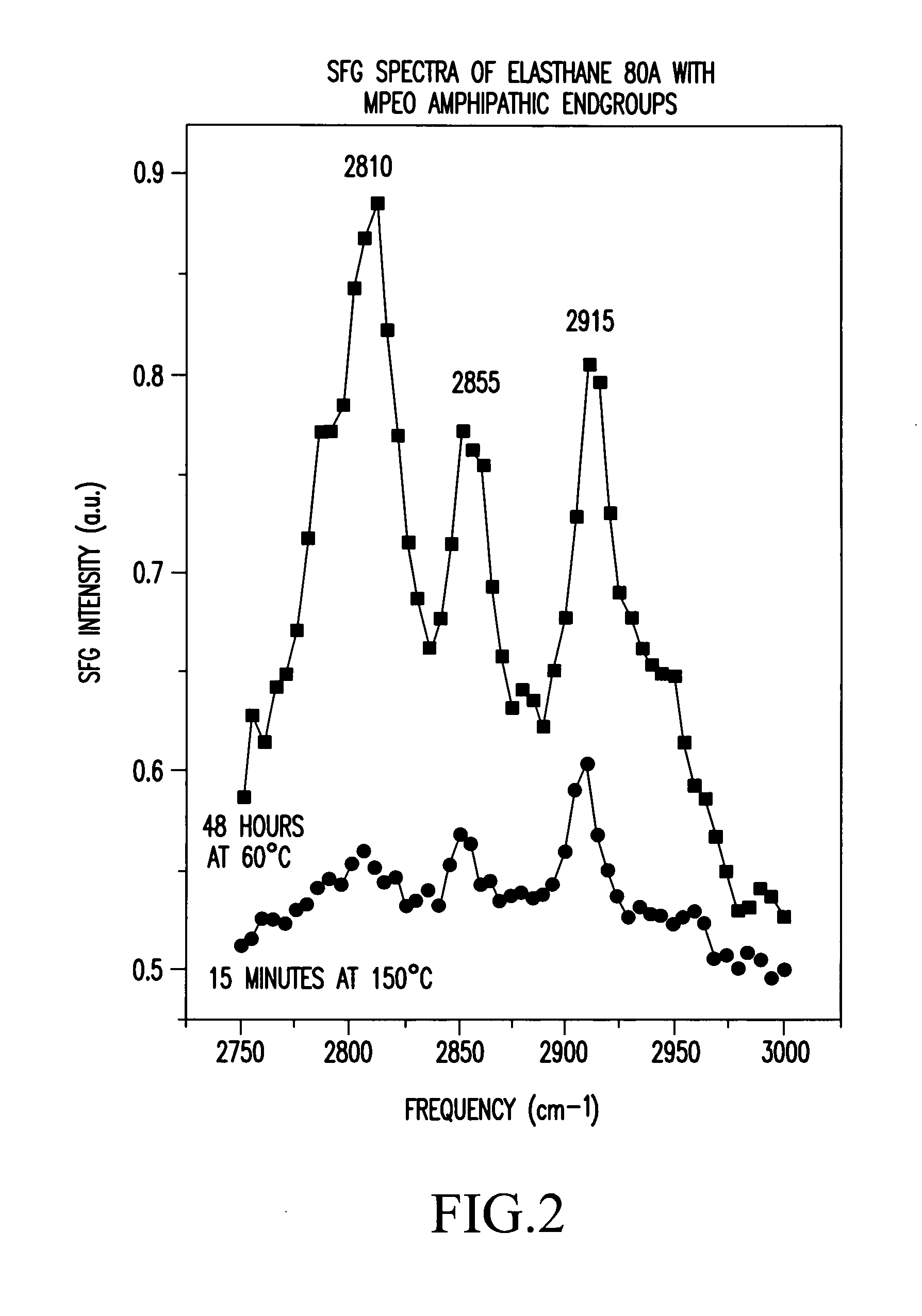Control of polymer surface molecular architecture via amphipathic endgroups
a technology of amphipathic endgroups and which is applied in the field of control of polymer surface molecular structure via amphipathic endgroups, can solve the problems of reducing the application range of attenuated total reflection infrared spectroscopy (atr-ir), requiring surface sensitivity, and not providing specific information about the chemical nature of the outer monolayer. , to achieve the effect of enhancing aerodynamic or hydrodynamic drag
- Summary
- Abstract
- Description
- Claims
- Application Information
AI Technical Summary
Benefits of technology
Problems solved by technology
Method used
Image
Examples
example 2
Elasthane 80A with MPEO Amphipathic Endgroups
[0078] These Elasthane 80A polymers have endgroups of the formula
FIG. 2 shows the SFG spectra of these Elasthane 80A samples, exposed for 48 hours at 60° C. and 15 minutes at 150° C. The sample treated at 60° C. was very opaque due to the cloudy film. A large peak was observed at 2810 cm−1. The sample treated at 150° C. was slightly opaque, and the peak at 2810 cm−1 was considerably smaller. This change in the peak ratios between spectra is due to a reorientation of surface species in the amphipathic endgroups, which results in a change in the surface concentration of one species (etheric oxygen) relative to another (CH2).
example 4
PurSil 20 80A with MPEO Amphipathic Endgroups
[0080] These PurSil 20 80A polymers have endgroups of the formula
FIG. 4 shows the SFG spectra of three samples of PurSil 20 80A with MPEO amphipathic endgroups. One sample is a control, one sample was exposed for 48 hours at 60° C., and one sample was exposed for 15 minutes at 150° C. All three samples exhibited the cloudy film, and both the control and the sample treated at 60° C. revealed large peaks at 2810 cm−1. The control sample also revealed a resolved peak at 2880 cm−1, while the 60° C. sample and the 150° C. sample exhibited only shoulders at this frequency. The peak at 2880 cm−1 is most likely due to the asymmetric stretch of the methyl groups that terminate the polymer chains. The symmetric O—CH2 stretch peak is either hidden by the 2810 cm−1 peak or the vibrational mode is parallel to the surface. The signal-to-noise ration of the 150° C. sample is smaller due to the poor reflection quality of the sample.
example 6
PurSil 20 80A with MPEO Amphipathic Endgroups
[0082] These PurSil 20 80A polymers have endgroups of the formula
FIG. 6 shows the SFG spectra of two samples of PurSil 20 80A with MPEO amphipathic endgroups. One sample is a control, and one sample was heated in deionized water for 1 hour at 100° C. The large peak at 2810 cm−1 is observed for the untreated sample. After heating in deionized water for 1 hour, the 2810−1 peak is no longer observed. At this point, only features at 2845−1, 2910−1, and 2955−1 are seen in the SFG spectrum. Also, the cloudy film was not observed for the sample heated in deionized water.
PUM
| Property | Measurement | Unit |
|---|---|---|
| weight average molecular weight | aaaaa | aaaaa |
| weight average molecular weight | aaaaa | aaaaa |
| weight average molecular weight | aaaaa | aaaaa |
Abstract
Description
Claims
Application Information
 Login to View More
Login to View More - R&D
- Intellectual Property
- Life Sciences
- Materials
- Tech Scout
- Unparalleled Data Quality
- Higher Quality Content
- 60% Fewer Hallucinations
Browse by: Latest US Patents, China's latest patents, Technical Efficacy Thesaurus, Application Domain, Technology Topic, Popular Technical Reports.
© 2025 PatSnap. All rights reserved.Legal|Privacy policy|Modern Slavery Act Transparency Statement|Sitemap|About US| Contact US: help@patsnap.com



